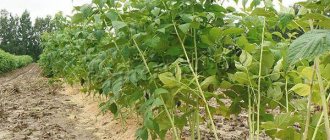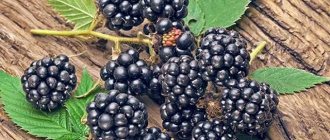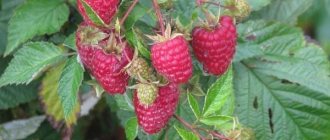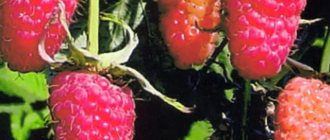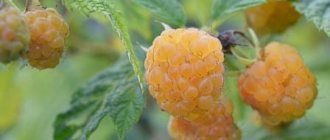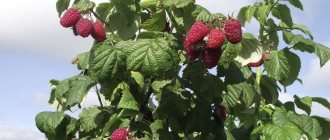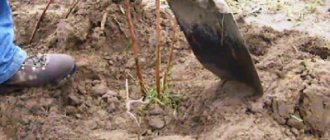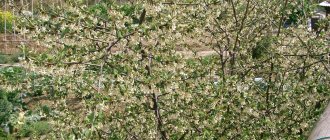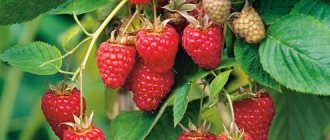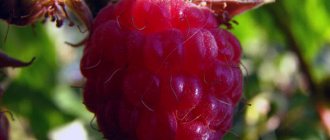Description and characteristics of the variety
The bushes of this variety have spreading, thickened shoots, their height is 2 m. The annual brown branches are covered with a waxy coating. Biennial stems are brown in color. The leaves of the Taganka raspberry are large, green, with grooves along the edges. The stems have small, soft purple thorns that are not particularly inconvenient during harvest.
The bush forms 4-5 shoots, 8-12 replacement shoots and 20-24 fruit branches, from which 20-30 berries can be collected. The fruits are large, weighing 5–10 g, red, conical in shape. The berry is covered with a thin, dense peel. The pulp is burgundy, sweet, juicy. When harvested, the fruits do not lose their shape. In terms of taste, Taganka raspberries received 4.7 points.
Description of the variety
The external characteristics of the Taganka raspberry bush are as follows:
- strong shoots up to 2 m high;
- thick and long spines are located on the lower part of the branches;
- on new shoots the thorns are softer;
- each bush produces up to 10 shoots;
- medium degree of density and spreading of the bush;
- two-year-old shoots are brown in color;
- young shoots have a brown tint;
- The frost resistance of the Taganka variety allows it to withstand temperatures down to -20 degrees.
According to reviews and photos of Taganka raspberries, the description of the variety is as follows:
- large berries weighing 5-6 g;
- elongated fruits;
- juicy pulp and pronounced berry aroma;
- fruit ripening occurs evenly;
- good transportability.
The Taganka variety is remontant. At the beginning of summer, the berries ripen on last year's shoots, and in the middle of the season, annual stems produce a harvest. The formation of the first harvest weakens the plant, and subsequently smaller berries are born. If you need to get one, but abundant harvest, then old shoots need to be pruned in the fall.
Advantages and disadvantages
Like any crop, this variety has pros and cons when grown.
- The benefits of Taganka raspberries include:
- rich harvest: 5 kg of berries per bush;
- large fruit size;
- resistance to diseases.
The disadvantages of the variety include the fact that the berries are not intended for long-term transportation, as they quickly begin to crack and at the same time lose their appearance.
Drought resistance, frost resistance
The Taganka or Taganok variety has high winter hardiness ; the above-ground part of the bushes can withstand frosts down to -20°C, which is its advantage. The variety is also drought-resistant, but during long dry periods the fruits become smaller, which deteriorates their quality.
Landing rules
Site selection
Raspberry Taganka is unpretentious, but requires careful selection of a planting site. The area should be protected from the wind and well lit by the sun. The variety can grow in partial shade, but the yield is significantly reduced. This raspberry develops and bears fruit best on light loamy soils well amended with organic matter.
More on the topic: What are the advantages and disadvantages of the Ugolek variety
Before planting, the area must be completely cleared of weeds. If the soil is not fertile enough, it is enriched with high-quality compost, which is added by deep digging of the soil.
It is not advisable to add lime to slightly acidic soils, but highly acidic soils should be limed about a year or a year and a half before planting.
Planting scheme
Remontant raspberries can be planted in spring or autumn. Complex fertilizer is applied to the holes or furrows and fertile soil is added. When planting in the fall, you should not use nitrogen-containing fertilizers - they slow down the rooting of plants.
The seedlings are lowered into holes and dug in. In this case, it is necessary to shake the plants slightly so that the entire space between the roots is filled with soil.
Landing Features
Before you start planting, you need to familiarize yourself with the timing of planting, the choice of planting material and place for planting, as well as the technology for planting bushes. You will learn about these and other details below in the article.
Deadlines
Raspberries can be planted in autumn or spring. The second option is more reliable, since the bushes will take root better. If you are going to plant raspberries in the southern region, then you can plant them in the fall. Before planting a plant, it is necessary to choose a suitable place for its further life.
Did you know? When bees collect nectar, they increase raspberry yields by 60-90%. Since the flowers of this crop are turned downwards, insects can try to escape from them during rain.
Choosing a suitable location
When choosing a site for planting, you need to pay attention to the soil: it must be loose, well permeable to moisture and air. In this case, groundwater should be located at a distance of 1 m from the ground level, since stagnation of water can lead to rotting of the raspberry root system, as a result of which the bushes will die.
It is best to plant it on the south-west side of the site, since this way the plant will receive enough sun and heat. However, it should not be exposed to drafts.
In this regard, planting should be done near fences or any hedges, because strong winds can damage the stems and also disrupt the activity of insects with the help of which the plant is pollinated. To prevent this problem, it is necessary to make strips of earth along the fence that protect the raspberries from the wind.
Important! This crop should not be planted in the place where tomatoes, potatoes, and peppers were previously planted, since these products deplete the soil and draw out many useful substances from it.
Selection and preparation of planting material
The choice of planting material must be approached carefully; it is best to buy seedlings from trusted nurseries. When choosing seedlings, you need to pay attention to the root system: it must be well developed, the roots must be fresh, not have defects, rot or be too dry.
Raspberry shoots must be healthy and undamaged. If this variety grows on your site or among your neighbors, you can get seedlings yourself by dividing the bush. To do this, you need to select healthy shoots and remove them during the pruning period, while capturing the maximum number of roots.
Taganka is a remontant raspberry , therefore in 2-3 cases the properties of the mother plant are preserved, so the plant can be propagated using seeds. To get seedlings from seeds, you need to put ripe berries in a nylon bag, crush them and rinse with water at room temperature, then dry and store at a temperature of +1...+3°C. They can be sown in early spring to a depth of 5 cm.
Landing algorithm
Before you start planting, you need to prepare the soil in advance. After harvesting, the area is cleared of weeds, fallen leaves and dug up. At the same time, you can add fertilizer: 2.5 buckets of manure, 150 g of wood ash (this amount is calculated for 1 m²).
Did you know? Russia is the world leader in raspberry cultivation; about 200 tons of berries are harvested in this country every year.
Once the soil is prepared, you can proceed to the following steps:
- dig a trench measuring 40x50 cm, the distance between seedlings should be 1.5 m, and the row spacing should be 2 m;
- then place 12 kg of humus compost, 200 g of superphosphate and 120 g of potassium salt in the trench, this amount is calculated for 1 m²;
- sprinkle the applied fertilizer with soil;
- then inspect the seedlings again; if there are dry or damaged roots, they need to be cut off;
- after this, the root system of the bush is placed in a mixture of water and clay and kept there for 2 hours;
- as soon as the specified time has passed, the seedling is removed and installed in a trench, while the root collar should not be below the soil surface;
- the roots are straightened, then they are sprinkled with soil and the soil is carefully compacted;
- Next, you need to cut the stems to a growth bud at a level of 20 cm from the ground;
- at the end the bushes need to be watered; a bucket of water is consumed for 1 bush. As soon as the soil absorbs moisture, it must be mulched with humus.
Watering and fertilizing
Proper watering of the crop is weekly in the mornings or evenings using the sprinkling method. During drought, water should be added every 2-3 days. It is important to avoid waterlogging of the soil and stagnation of water, so that the roots do not rot and infections develop. The main periods of watering are the beginning of flowering and fruit ripening; at this time, water should saturate the soil 35 cm deep.
Feeding is applied 3 times per season:
- in spring, before flowering, use organic fertilizers;
- in summer, during the growth of shoots, mineral supplements are added;
- in autumn, after fruiting, organic complexes are used again.
The procedures are carried out the next year after planting. An infusion of mullein (a waste product of cattle) in a ratio of 1:10 in an amount of 5 liters per 1 square meter is suitable as an organic fertilizer in the spring. m raspberry. In the fall, it is worth adding humus or rotted (but dried) manure to the soil - 1 bucket for each bush.
Peculiarity! After the berries begin to ripen, it is advisable to introduce an additional portion of diluted mullein or potassium fertilizer into the soil. This will improve the taste of the fruit.
Care
After planting, the plant needs careful care. It includes timely and correct watering, regular fertilization, pruning and garter. It is necessary to water raspberries regularly, as they are vulnerable to severe drought and lack of moisture can affect the quality and quantity of the harvest.
Particular attention should be paid to watering at the time of formation of ovaries and during the period of fruit ripening. Taganka should be watered once every two weeks in the morning or evening. There are two ways to moisten raspberries - by sprinkling or pouring water directly into the irrigation furrows.
One bush consumes 10–15 liters of water . Also, after watering, you should loosen the soil so that it quickly absorbs moisture and, if necessary, gets rid of weeds. Since the raspberry root system is close to the surface, the loosening depth should be 5–10 cm.
This variety can be grown as an annual or biennial plant . When growing the first option, after harvesting, all stems are cut to ground level so that no stumps remain. If you live in a cold region, then it is best to grow raspberries as two-year-old ones, and you will only need to cut off last year's stems.
In the spring, sanitary pruning is carried out, which includes removing dry, defective and damaged stems to a healthy bud. If the bushes are too thick, they will need to be rowed, and also if all the shoots are outside the row, they should be removed.
Gartering the bushes is necessary in order to make it easier for the robot to care for the plant. Tie the raspberries to the supports. Trellis are used as support: single, double and Scandinavian. The most popular are the first two options.
To tie raspberries to a single trellis you need:
- dig pillars, the height of which should be 2.5 m and the depth 50 cm;
- the gap between the pillars should be 4-5 m;
- then it is necessary to stretch the wire between the pillars at a height of 1 and 1.5 m.
To tie raspberries to a double trellis you need:
- dig pillars, the height of which should be 2 m and the depth 50 cm;
- the gap between the pillars should be 4-5 m;
- then attach a crossbar to all the posts, the length of which should be 50 cm and the width 5 cm;
- then stretch the wire between the crossbars at a distance of 50 cm from each other, at a height of 1 m and 1.5 m from the ground surface;
- then pull a wire or rope every 60 cm.
In order to get a rich harvest, the plant must be fertilized in a timely manner. Fertilizing should be done every year, starting 2 years after planting.
Important! Also, every 3 years, raspberries need to be fed with organic fertilizers. As organic fertilizers, you can use a solution of mullein, goat, rabbit droppings in a ratio of 1:10 or bird droppings in a ratio of 1:20. One bush will need 10 liters of solution.
Taganka raspberries should be fertilized during the following periods (the amount of minerals is calculated for 1 bush):
- In March, it is fertilized with a solution of 15 g of ammonium nitrate and 10 liters of water.
- Before flowering begins, a solution of 20 g of potassium sulfate + 30 g of double superphosphate diluted in a bucket of water is added.
- During the period of fruit development, fertilize with a solution: 20 g of potassium sulfate, 20 g of double superphosphate and 40 g of Uniflor-Micro fertilizer, diluted in a bucket of water. One bush will need a liter of solution.
- In October, it is fertilized with a solution of 20 g of potassium sulfate and 40 g of superphosphate, diluted in a bucket of water.
Video: Remontant raspberry. Features of planting and care
Planting and care
For healthy growth and abundant fruiting of raspberries, it is necessary to choose the right place for planting. The following conditions are important:
- the area is sunny, but protected from drafts and gusts of wind;
- the absence in the immediate vicinity of non-remontant varieties from which wintering pests can migrate;
- the absence of other crops that create shade for Taganka and complicate care between the rows;
- distance from nearby groundwater (if available, bushes should be planted on high beds or mounds);
- exclusion of planting the crop in an area from which old raspberry bushes were previously uprooted.
Attention! If the variety is planted in the southern regions, then care should be taken to protect it from heat and drought. You can place tall plants, such as corn, next to the raspberry tree.
The culture transplantation process consists of the following steps:
- Prepare holes: 50-60 cm deep, about 45-50 cm wide. Add complex mineral fertilizers (50 g) to each of them;
- Pour some soil into the hole and arrange drainage (pieces of broken brick or large crushed stone), then another layer of soil, and a seedling into it.
- Spread the roots of the bush and sprinkle them with soil, which is then leveled and compacted until a hole is formed.
- Pour 10 liters of water under each seedling, wait a little, after absorption, lift all the bushes until the root collar is 4-6 cm above the surface.
- Fill the hole with earth, trample it down, mulch using peat, nettles or dry straw.
The best time to plant the crop: autumn, from the end of September to the last days of October, at an average daily temperature of 8-10°C. It is also possible to replant Taganka raspberries in early spring, after the soil has thawed.
Proper care includes measures such as:
- watering;
- feeding;
- weeding (regular removal of organic debris from the soil - old leaves, dead branches, dead fruits, as well as weeds);
- pruning;
- garter;
- mulching.
Timely and correct implementation of all activities will ensure good growth of the raspberry tree, its healthy ripening and fruiting.
Harvesting and storage
The fruits of this variety ripen in mid-August. The duration of fruiting lasts a month. In warm regions, harvesting can be done at the end of November. From one bush you can collect 5–7 kg of berries. They must be placed in containers in one layer so that they are not damaged under their own weight.
The resulting harvest can be stored in the refrigerator for about two days. The fruits are used to make compotes, jam, jelly, juice and dessert fillings. Despite the fact that raspberries cannot be stored in the refrigerator for a long time, they can be frozen and enjoyed with fresh delicious berries in the winter.
Reviews from gardeners
Stepan, 38 years old, Ulyanovsk
I have been growing remontant raspberries for five years now. Before purchasing, I studied the description of the variety, photos, and reviews of Taganka raspberries. The shrub is guaranteed to produce a summer harvest on last year's shoots, and produces many flowers and berries in the fall. In warm weather they have time to ripen. The bushes are very powerful and the berries are large. The taste is decent, although there are sweeter varieties. In winter, the shoots need to be bent so that they do not freeze.
Vasily, 56 years old, Irkutsk
Raspberry Taganka is one of the best varieties on my site. It gives stable high yields. The berry is very large and tasty. The bush produces about 12 shoots, of which I leave seven. The branches are not thick, they can be easily bent to the ground. I don’t have any problems with care, I follow the standard scheme: watering, fertilizing, pruning.
Svetlana, 29 years old, Rostov-on-Don
Taganka raspberries in our conditions ripen closer to the second half of August. Peak fruiting occurs in early September, but we collect the berries before the first frost. Planting and caring for Taganka raspberries in the Kuban includes proper feeding and pruning. After the onset of cold weather, I prune the raspberries at the root. In this state, the plant tolerates winter better, and new shoots appear in the spring. Flowering begins in July. The berries ripen on young shoots. From one hundred square meters I collect up to 250 kg of berries, which go well for sale.
Preparing for winter
Preparing raspberry bushes for wintering is the most important process that affects the amount of harvest and the further life of the plant. If you have cut off all the stems, then no special preparation for winter is required; you just need to mulch the rows with peat so that the root system is not damaged during wintering.
If the stems are not cut, you need to do the following:
- remove leaves from the shoots; to do this, you need to put on thick gloves and run them along the stems from bottom to top. This procedure is necessary so that new kidneys can form;
- then connect the bushes together and tie the shoots;
- wrap in lutrasil or spunbond.
These steps must be completed a month before the onset of frost.
Raspberry pests
Taganka is quite resistant to the usual range of pests and diseases. Still, not a single plant has 100% resistance, and some diseases and harmful insects need to be feared.
Raspberry beetle
A small, “hairy” beetle that is yellowish-brown in color. Attacks buds, flowers and leaves. The larvae damage the berries by making tunnels in them. As a result, the berries become deformed, become small and often rot.
More on the topic: Self-fertile raspberry varieties Turner and Usanka
What to do: destroy the beetles manually. Treat with Fitosporin or Karbofos. Repeat treatments at intervals of 2 weeks until the pests disappear.
Spider mite
It sucks the juice from the leaves and entangles them in a web. The affected leaves curl and dry out, and if the infection is severe, the entire bush dies.
How to fight: half a month before the flowering period, spray with a 1% solution of colloidal sulfur (75–80 g per 5 liters of water).
Spray with garlic infusion (0.1 kg of chopped garlic and 40–50 g of soap, pour 10 liters of hot water, leave for 4 days).
Raspberry shoot aphid
Colonies of insects settle on the stems, sucking the juices from the leaves and tops of the shoots. The leaves begin to curl, dry out and fall off.
Control measures: before flowering, spray with insecticides (Fufanon, Nitrafen 2%, Karbofos 0.2%).
Trim and burn heavily affected parts of the shoots.
Reproduction methods
Taganka raspberries can be propagated in several ways.
Below we will consider each of the methods in more detail:
- Seeds . For this, overripe berries are used, which are placed in a bag and the juice is squeezed out of them, then washed with water and dried. Before sowing, seeds require long-term stratification.
- Root suckers . At the end of summer, young raspberry shoots with several leaves and separate roots can be seen near mature bushes. With the beginning of autumn, they need to be dug up in such a way as not to damage the root system and transplanted to a previously prepared place.
- Using pieces of rhizome. To do this, you need to cut the root into 10–15 cm pieces and dig it to a depth of 5 cm. Young shoots will sprout quickly.
Diseases of Taganka raspberry
Purple spot
The leaves, young shoots and buds are covered with a violet-brown hue that does not have clear boundaries. The spots grow and cover the shoots in a ring. The bark peels off and falls off. Defeat can occur during the entire growing season.
Ways to fight:
- Cut off diseased shoots, taking a piece of the underground part.
- Ensure good ventilation of plantings (thin out).
- Water moderately, avoiding excessive soil moisture.
- During bud break, treat with 1% Bordeaux mixture. In summer, repeat spraying 3-4 times.
Anthracnose
Small gray spots with a purple outline appear on leaves, buds and shoots, as well as fruit branches and berries. They steadily spread and the plant dries out.
Prevention:
- 12–14 days before flowering, spray with Bordeaux mixture (0.3 liters per bucket of water).
- 2 In summer, spray with Oxychom (30–40 g per 10 liters of water).
- 3Avoid stagnation of moisture, create good drainage.
- Thin out plantings.
- Do not plant Taganka raspberries close to regular varieties.
Powdery mildew
In the first 4–5 weeks of summer, a white powdery coating appears on the leaves (both below and above). Growth points can also be affected, which become deformed and growth stops. Diseased leaves dry out, the volume of the harvest and the quality of the berries decreases.
Prevention:
Before bud break, twice during the flowering period, then after it, treat with copper sulfate (1%) or Fitosporin (3 teaspoons per bucket of water).
Remove all fruiting stems immediately after picking the berries. Collect and burn dried leaves.
Diseases and pests
Despite its resistance to fungal diseases, Taganka is susceptible to a number of other diseases, as well as the emergence of pests that can cause significant damage to both the crop and the plant.
This variety is subject to the following diseases:
- Mosaic . When this disease appears, the leaves of the plant change shape and color and wrinkle. Light and dark spots appear on their plates. Fruiting deteriorates significantly. The fruits lose their shape - they become dry and hard, the shoots become thinner. In order to get rid of the disease, it is necessary to uproot the infected bushes and burn them.
- Witch's broom . Shoots appear on the bush that do not bear fruit; the number of such shoots can reach 200 pieces. Young shoots grow up to 20 cm, the leaves become small, and the yield decreases. In order to get rid of the disease, you need to dispose of infected bushes.
- Root cancer . The infected plant slows down in growth. The berries lose their taste. When replanting, growths with a diameter of 5 cm can be found on the root of an infected plant. To cure raspberries, you need to disinfect the roots with a solution of 100 g of copper sulfate and a bucket of water; the bush must be kept in the solution for 10 minutes. As a preventative measure, it is necessary to maintain the acidity of the soil and replant the bushes every 3-4 years.
- Curly . Brown spots appear on the bottom of the leaves, the leaf blade becomes hard, and the veins become glassy. The fruits lose their shape and their taste. Raspberries die after a few years. It is impossible to get rid of this disease. Infected bushes are disposed of.
In addition to diseases, the following pests can cause harm to Taganka:
- Aphid . The first sign of infection is the appearance of several insects on the inside of the leaf. They feed on their sap, causing the leaves to curl and turn yellow. In spring, you can detect the appearance of larvae at the top of the stem. To get rid of the pest, you need to spray the tops of the shoots with a soap solution (dilute 300 ml of liquid soap in a bucket of water) or spray with a mixture of 15 g of anabasine sulfate. As a preventive measure, after harvesting, fallen leaves are collected and burned, and shoots that bear fruit are removed. The soil is dug out under the bush to a depth of 15 cm.
- Raspberry fly . Larvae appear on the stem, which eat the tissue of the shoots, as a result of which they turn black and wither. In order to get rid of the pest, you need to treat the raspberries with Parisian greens, the concentration of which should be 0.15%. As a preventive measure, you need to dig up the soil under the bush.
- Weevil . A sign of damage by this pest is a bitten stalk, which is why the buds begin to fall off. To get rid of it, you need to use Parisian greens (0.15% concentration).
- Glassware . These are caterpillars that crawl into plant stems and reproduce in them. In this case, the raspberry branches quickly die. Glasswort can be detected by cutting the shoot. The disease is also indicated by rotting of the stem core. To get rid of the pest, the same remedy is used as for the raspberry fly. As a precaution, infected raspberry shoots are disposed of.
- Raspberry moth . A sign of this pest is the appearance of abscesses on young shoots. They are formed due to the fact that an insect lays eggs under the bark of a plant. The caterpillars feed on the juices of the raspberry buds, so the ovaries begin to gradually die. The fruits on an infected bush grow small and lose their shape. For disposal, Parisian greens are used (concentration 0.15%). Preventive measures: removal of infected shoots.
Raspberry Taganka is not demanding in care . In order to get a rich harvest, you should adhere to the rules of planting and further care of this variety. With timely watering and fertilization, you can get a good harvest and prepare various dishes with berries: jams, desserts, compotes and preserves. And awareness of all kinds of diseases and pests will help you continue the life of this variety for many years.
Features of growing raspberries
To successfully cultivate raspberries, you must follow simple agrotechnical rules - water, prune, weed and feed on time.
Watering, pruning and tying up
Taganka is very demanding when it comes to watering - it suffers from both excess and lack of water. If there is no moisture for a long time, the berries lose their taste and become smaller, and the yield decreases. Raspberries need to be watered regularly, but not too much. The main need for moisture occurs during ovary formation and ripening of berries. Typically, plantings are watered twice a month, in the morning or evening. Until flowering occurs, it is recommended to water by sprinkling; the rest of the time, water is supplied to the furrows at the rate of 20–25 liters per linear meter.
Raspberries respond well to sprinkling irrigation
Taganka raspberries can be cultivated as a one- or two-year crop. In the first method, after harvesting, all shoots are cut to the ground. In regions with cold climates, cultivation using the second method is recommended. In this case, only the shoots of last year are pruned in the fall.
In spring, plantings are inspected and dry and damaged areas of shoots are removed to a healthy bud. If the planting becomes very thick, the plantings should be thinned out.
Raspberries tend to “spread” beyond the boundaries of their site, so all root shoots that appear outside the boundaries of the site, as well as in the inter-row spaces, must be removed.
Recent Entries
5 working ways to use tar in the garden 7 indoor plants that help you get married even in adulthood Indoor plants that can bloom in trouble
Video: pruning remontant raspberries
Tying serves not only to protect the stems from breaking by the wind or under the weight of the crop, but also makes it easier to care for the plantings. The most common type of support for raspberries is a single trellis. To construct it, poles 2.5 meters high are driven into the ground along the raspberry row, and several rows of support wire are stretched over them. If no protection from the wind is provided, the raspberry stems must be tied to a support wire, otherwise the shoots may break on it.
Video: features of caring for remontant raspberries
Fertilizing, soil care and preparation for winter
To obtain a full harvest, it is necessary to regularly fertilize the raspberry tree. Plants begin to be fed from the second year. Every spring, nitrogen compounds should be applied (for example, 15–20 g/m2 of ammonium sulfate), at the beginning of summer - organic fertilizers (rotted manure, compost) at the rate of 5 buckets per 1 m2, and in the fall - potassium salts (30 g/m2) . Every three years it is necessary to add phosphorus compounds to the spring feeding (for example, 55–60 g/m2 of superphosphate). Organic matter is added by digging up the soil, and minerals are scattered over the surface of the soil, mixed with a pitchfork and watered.
In addition to traditional fertilizers, you can use complex fertilizers for feeding.
In addition, during the flowering period in summer, it is recommended to cover the ground near the bushes with a layer of humus. After flowering, liquid fertilizing is carried out with a solution of fresh chicken droppings (1 shovel per bucket of water).
The soil on a raspberry plantation must be kept loose and free of weeds. Loosening is carried out as soon as the soil dries out a little after the next watering. The depth of treatment should be no more than 6–7 cm so as not to touch the roots.
Before wintering, cut out all last year's shoots at the root.
Taganka needs to be covered for the winter due to its low winter hardiness. First of all, pruning is carried out and all cut stems are eliminated. For full fall pruning, you simply cover each row with peat mulch. If the current year's shoots are left for the winter, they are tied together, bent to the ground and covered with straw, spruce branches or non-woven covering materials.
Protection from pests and diseases
Taganka exhibits sufficient resistance to most pests and diseases common to raspberries. However, among the pests you should be wary of the raspberry beetle, and among the diseases - purple spot.
The raspberry beetle actively damages almost all parts of the raspberry bush
The raspberry beetle is a “universal” pest, as it eats inflorescences, buds, and leaves. In addition, the beetle lays eggs in flowers, and the emerging larvae gnaw at the berries, which become smaller and rot. Beetles can be knocked off bushes onto spread polyethylene or cloth and then destroyed. Chemical preparations are also used: Fitoverm (in the last ten days of May), Confidor, Kinmiks, Iskra.
Video: how to treat raspberries against pests
Purple spot, or didimella, is one of the most dangerous and common raspberry diseases. Typically, the onset of the disease is observed in June in the form of dark spots with a purple tint on the leaves and buds. If no measures are taken, the area of the spots increases, the bark begins to crack and peel. To reduce the spread of the disease, thickening of plantings should not be allowed. Diseased shoots are cut out with part of healthy tissue. Watering should be moderate. Among the chemical means of protection used:
- Bordeaux mixture (first time when the buds open, then three more times);
- Kuproxat (50 ml per bucket of water);
- Fundazol (20 g per bucket of water).
Purple spot is a very common and dangerous raspberry disease.
Anthracnose is an even more unpleasant disease because it is difficult to treat. Appears as brown spots on leaves and stripes on stems. Over time, the area of these damages increases. The surface of the stains becomes depressed and cracks, and with high humidity, rotting begins.
At the onset of the disease, brownish spots appear on the leaves.
Prevention of the disease is to keep raspberry plantings clean and, if possible, away from other berry crops, as well as timely thinning and fertilizing with potassium-phosphorus fertilizers. Among the chemical means for the prevention and treatment of anthracnose, preparations containing copper are recommended - copper sulfate, Oxychom, Kuproxat.
How to collect and preserve the harvest
Fruiting of Taganka raspberries begins in the first half of August and lasts until mid-October (weather permitting). Raspberries are picked by hand and very carefully - they crumple extremely easily. Ripe Taganka berries are easily separated from the stalk, so do not try to separate the berries by force. The collected fruits are placed in boxes, small plastic buckets or containers.
It is advisable to lay the berries in layers, covering them with raspberry, hazelnut or horseradish leaves. The same leaves should be placed on the bottom of the container.
Fresh berries can last 5-6 days in the refrigerator, but you can keep raspberries fresh all year round by freezing the berries in plastic containers. Taganka is also well suited for making jams, wines, fruit pies and other delicacies. You can use not only berries, but also raspberry leaves - they are part of herbal teas.
Raspberries make an excellent filling and decoration for fruit pies.
Reviews from netizens
I have had Taganka raspberries growing and bearing fruit for 5 years now. A variety of normal fruiting type, large berries of a typical raspberry color. The variety is very early, this year I was already selling berries on June 10, the berries are very tasty. I have about 15 varieties of raspberries, and Taganka, in my opinion, is the most delicious. Its shoots are small, 70-100 cm. and not very thick, so its seedlings next to modern varieties look second-rate and are reluctant to buy them. But when it begins to bear fruit, they come and thank you. So it was with me. This variety sucks very hard but overwinters well.
Nikolka
https://forum.vinograd.info/showpost.php?p=488662&postcount=4
Reviews
Reviews about Taganka raspberries are contradictory. It often happens that seedlings are bought at the market, and it is very different from the original variety. Hence the confusion in her characterization.
It is better to buy varietal raspberries in nurseries and trusted stores.
Some believe that this variety is not very suitable for transportation and storage. However, other reviews note that the berries do not spoil for a long time.
In regions with cold winters, the bushes will have to be bent under the snow, and in the absence of it, shelter will be required.
But still, there are more positive reviews than negative ones. The fruits are used fresh, used to make preserves, jams, marmalades and compotes.
Gardeners love Taganka raspberries for their fairly simple cultivation techniques, hardiness, and high yield. This is a promising and popular variety. The emergence of new products will not give it much competition.
Reproduction methods
Raspberries of this variety are easy to propagate. A plant older than 2 years is suitable for this. It is recommended to take young shoots from it and plant them in a new place. Taganka seedlings seem small. But they take root well and begin to grow quickly.
Healthy plants that produce a bountiful harvest are suitable for propagating raspberries. They must have lateral shoots that have a lignified trunk. It is important that the shoots grow at a distance of 30 centimeters from the main plant and have a height of 10-20 centimeters.
The shoots should be dug up with a lump of soil and moved to a new place.
Main characteristics
The separation of fruits from the stalks is dry. Tasting assessment of Taganka raspberry fruits is 4.2-4.3 points out of 5 possible.
Raspberry variety Taganka - characteristics - video
The bushes are characterized by fairly high resistance to frost and can easily tolerate cold temperatures down to -20 degrees Celsius.
However, Taganka raspberries are not very resistant to periods of drought - this raspberry tree needs to be watered regularly, otherwise the bushes will slow down their growth, and the berries will become smaller, and their taste will become more sour.
On a note!
Fruiting occurs on last year's shoots from the end of July, and on the current year's shoots - from the end of August until almost the first frost.
The harvested crop does not tolerate transportation over different distances very well, and is also not stored for long, since the berries quickly become soggy.
Therefore, gardeners recommend processing the collected berries immediately after harvesting.
Raspberries of this variety are distinguished by their universal use - the berries are eaten fresh, jams and jams are made, but they are not suitable for freezing, as they quickly turn sour.
Description of Raspberry Reward
Bushes of the Nagrada variety are moderately spreading and grow quite tall - up to 2 meters. With quality care and favorable conditions, growth rates can increase. This type of raspberry is distinguished by rather massive and thick stems, about 2 cm in diameter near the base, which are also quite flexible: if there is a need to cover the shoots for the winter, this will not be a problem. Annual shoots are also quite thick and have long internodes, which are not pubescent, but have a waxy coating. Initially, the stems are green, but with the onset of cold weather they acquire a reddish tint. Raspberry Reward has practically no thorns: the few thorns that exist are located in the lower part of the stems. They are dark purple in color, wide at the base, long, but not sharp.
The leaves of the Nagrada variety are medium to large in size. Curl is medium.
The Reward variety, as a rule, does not spread over the area, while at the same time producing a decent number of root seedlings that tolerate transplantation well, but are poorly transportable.
Opinions differ about the ripening time of this variety. Some classify the Award as a mid-early breed, while others classify it as a mid-late breed. Differences in opinions are due to weather conditions: if somewhere in the Kuban the harvest is harvested at the end of June, then in Siberia or the Urals at least two weeks later.
As mentioned above, Reward is quite prolific, although less prolific than modern raspberry species. From each Reward bush you can collect about 3 kg of berries. Per hectare of raspberry fields - approximately 100-120 centners.
Fruit characteristics
Now briefly about the characteristics of the berries themselves:
- Dessert, sweet and sour “true raspberry taste”, pronounced aroma. It is generally accepted that the Reward is not very tasty when fresh, but the jam and compotes made from it are simply excellent!
- The berries are medium in size. Of course, there are significant differences between fruits growing in the northern and southern regions. The weight of the berry can vary from 2 to 6 grams;
- The berries are bright red, without a glossy sheen, which does not make them less appetizing;
- The pulp is medium dense, the drupes are moderately adherent to the fruit;
- Berries growing in one place are approximately equal in size.
Taganka - description of a remontant variety
Raspberry is a berry bush that is cultivated throughout Russia, where farming is possible. Raspberry bushes have a perennial root system and a two-year above-ground part. In this, Taganka is similar to its other popular “brothers”. But let's look at what is special about this particular variety.
The sun is in the yard, and there is a path in the garden. My sweet one, Raspberry Berry!
T. Volgina
https://chudesenka.ru/load/7–1-0–272
Origin of the variety
At the Institute of Horticulture (Moscow) in the seventies of the 20th century, Professor V.V. Kichina created varieties of large-fruited raspberries. Some of these varieties are remontant, that is, capable of growing berries on both annual and biennial shoots. These include the Taganka raspberry variety, obtained from crossing the Scottish variety 707/75 and the Krupna Dvroda raspberry. And for more than 30 years, this variety has been grown in gardens throughout Russia, despite the emergence of more and more new varieties.
The difference between simple and remontant raspberries
The main difference is in yield - the remontant variety is capable of bearing fruit for a very long time. The given diagram of the bush will help you figure out which parts of the plant are being discussed in this or that paragraph.
Diagram of a raspberry bush: 1 - two-year-old fruitful shoot, 2 - lateral branches, 3 - replacement shoot, 4 - suckers, 5 - etiolated (unlit shoots), 6 - roots, 7 - buds on the roots, 8 - rhizome
The differences between simple and remontant raspberries are as follows:
- simple raspberries produce a harvest in the summer on two-year-old shoots (they dry out after fruiting and are cut out), the replacement shoots of the current year are left to overwinter, because next season they will bear fruit;
- remontant raspberries can bear fruit in the summer on two-year-old shoots, and in the fall on replacement shoots of the current year.
Options for growing remontant Taganka raspberries
There are two options for growing and, accordingly, pruning the raspberry variety we are considering. Raspberries can be grown for 1 or 2 harvests; the raspberry yield, its taste and quality will depend on the choice of method.
For 2 harvests: summer and autumn
What does this method provide:
- a small harvest of your favorite berries on two-year-old shoots in June - July, depending on the region;
- a small harvest of your favorite berries on replacement shoots until September or even December, depending on the region;
- it is impossible to treat replacement shoots with copper preparations for diseases before flowering, since at this time two-year-old shoots bear fruit.
Video: remontant raspberries for 2 harvests
For 1 autumn harvest
What does this method provide:
- the berry harvest from August to September - December, depending on the region, is much higher than the total harvest in 1 case, since the bush does not waste energy on forming a summer harvest and replacement shoots grow strong;
- replacement shoots form the harvest 2 weeks earlier for the same reason;
- flowering and berry set occurs after the main pests (raspberry beetle, raspberry stem fly, raspberry bud moth) have already ceased their activity, and therefore the berries are clean, not worm-free and without chemicals;
- the plantation goes empty before winter, and therefore most of the disease carriers are destroyed;
- treatment with copper preparations before flowering does not raise any questions.
Video: remontant raspberries for 1 harvest
An analysis of publications on the topic showed that even in the southern regions, gardeners prefer the second method, and for the summer harvest they choose non-remontant varieties.
For a summer harvest, you can have varieties of different ripening periods in the garden.
Characteristics of the variety
Raspberry Taganka is considered one of the main professional achievements of breeder V.V. Kichins. The main advantage of the variety is its hardiness, that is, the ability to bear fruit even in unfavorable conditions. Of course, you shouldn’t expect a big harvest, but some other varieties may not even survive in such conditions.
Table: description of the bush
| Name | Characteristic | Advantages | Flaws |
| Bush | Strong, moderately spreading, height up to 2 meters. | Does not require a rigid garter, since the bush does not fall. Light tying of regrown shoots to the trellis is done in the summer so that future berries do not suffer from wind and shading. | — |
| Replacement shoots | Thick, hard, elastic. The bush independently forms few replacement shoots, only 3–4, of which the recommended number for remontant varieties (7–9) is formed by double pruning. | The garter to the trellis is not labor-intensive. | Additional labor costs for pruning. |
| Fruit branches (literals) | Strong, long, they have 2-4 orders of branching. | Produces up to 20 berries. | — |
| Leaves | Dark green, large, with a corrugated surface. | — | — |
| Spikes | On two-year-old shoots they are prickly, on shoots the replacements are tender. | Harvesting the autumn harvest is simplified. | — |
| Offspring | Not much, on average 4-5. | Removing suckers is not difficult. | There are few shoots, which, when propagated, leads to higher prices for seedlings. |
| Winter hardiness | Withstands temperatures down to -30 °C. | High. | — |
| Fruiting | Uniform. | Stable throughout. | — |
| Ripening time when cultivating one autumn harvest | Middle late. | Taganka bears fruit when other raspberry varieties have already faded away. In the southern regions it bears fruit when there is no intense heat, which increases the yield. It has proven itself very well in the south. | In the middle zone, it makes sense to have earlier remontant varieties on the site. During early frosts, some Taganka berries will not ripen. |
| Ripening time when cultivating two crops | Summer - early, autumn - mid-late. | — | Suitable for garden plots for personal consumption, if you like. |
| Productivity | About 4-5 kg per bush. | High. | This productivity is achieved with only one autumn harvest. |
| Disease resistance | Taganka is resistant to fungal diseases. | It has high resistance to various kinds of diseases. | — |
| Resistance to pests when cultivating one crop | Good. | It blooms and bears fruit after the main pests have finished their activity. In addition, due to the removal of all shoots, pests do not overwinter under the bark. Virtually no chemicals required. | — |
| Resistance to pests when cultivating two crops | On par with other raspberry varieties. | — | — |
| Endurance, unpretentiousness | Taganka can bear fruit even with some violation of agricultural technology, soil fertility, and watering. Ripe berries stay on the bush for several days. | Tall. | — |
Table: description of berries
| Name | Characteristic | Advantages | Flaws |
| Large fruit | The berries are large and very large (4-12 grams), some reach a weight of 23 grams. | The required mass (for example, for jam) is created by a smaller number of berries, which simplifies processing. | — |
| Taste | Sweet with sourness and pleasant aroma. | Has a pronounced aroma. Tasting score 4.7 out of 5 points. | It is slightly inferior to dessert varieties, for example, the summer variety Novost Kuzmina, remontant Anfisa, Yellow Giant. |
| Berries shape | Conical. | There are almost no double berries, all of the correct shape. | — |
| Berry coloring | Dark red, shiny. | Buyer demand. | — |
| Drupes | Medium size, tightly interlocked with each other. | The berry holds its shape and does not fall apart in your hands. | — |
| Skin | Thin but durable. | Retains its shape before processing or transportation for 4-6 days (in the refrigerator). | Fresh cannot be stored for more than a week, even in the refrigerator, but this applies to raspberries of any variety. |
| Pulp | Juicy. | When ripe it is too soft, but this is compensated by the possibility of ripening of unripe berries. | During storage or transportation, it quickly begins to leak. |
| Seeds | There are few seeds, the seeds are small and almost invisible. | They are few in number, which has a positive effect on the taste. | — |
History of the variety's creation
Taganka raspberries were bred in the last quarter of the last century by the famous Soviet breeder V.V. Kichina, who worked at the Breeding and Technological Institute of Horticulture and Nursery Growing, located in the Moscow region.
Photo of Taganka raspberry
To develop a new variety, this breeder crossed the Krupna Dvroda raspberry and a hybrid from Scotland 707/75.
The variety was included in the State Register in 1976
and is zoned for cultivation in most Russian regions due to its fairly high frost resistance.

